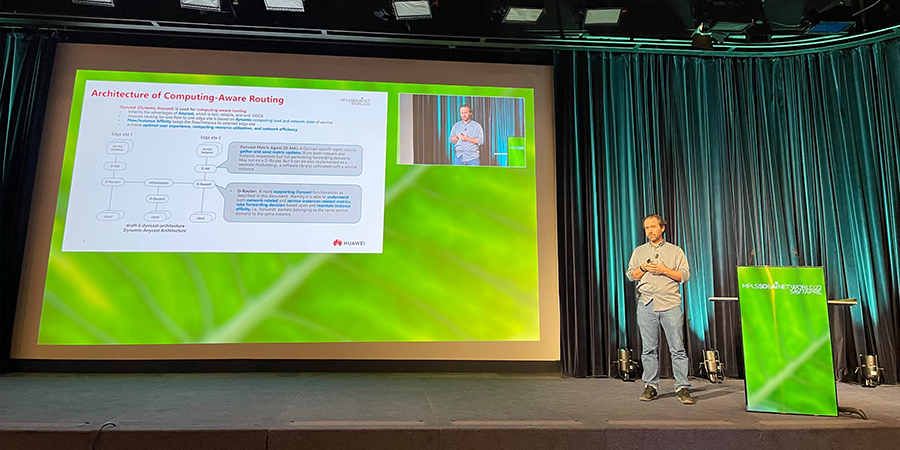The 23rd MPLS, SD & AI Net Network World Congress (known as the MPLS Forum) — the world's highest-level third-party forum in the IP field — was successfully held in Paris. During this congress, Luigi IANNNONE, IP protocol team leader of Huawei's Paris Research Center, delivered a keynote speech titled "Innovation of computing-aware routing in intelligent IP network", sharing Huawei's reflections on computing-aware routing innovations in the computing network era.
Ubiquitous connectivity and computing power required by the digital transformation of industries are drivers stemming from computing-aware routing. Computing power is becoming distributed instead of centralized. In order to jointly optimize and schedule network and computing power resources network-wide and provide comprehensive computing services for users, computing power and networks need to move from decoupling to convergence so that they can perceive each other.
The convergence of computing power and networks faces four challenges:
- Computing resource integration: Resources can be managed in a unified manner only after the computing power of multiple parties is marked and measured.
- Computing resource allocation: In consideration of application attributes, network costs (near-low and far-high), computing costs (near-high and far-low), and other factors, networks need to deploy computing tasks to appropriate locations.
- Edge computing collaboration: Edge computing nodes need to be networked to improve reliability. In this case, networks can facilitate the interconnection and collaboration of edge computing nodes.
- Computing service experience: Services and networks are completely decoupled and unaware of each other, meaning that user experience cannot be enhanced.
Computing-aware routing is essential to the convergence between the computing power and networks. It considers both the computing power and networks at the protocol layer to achieve optimal utilization of computing, storage, network, and other resources on the entire network, and ultimately deliver the best user experience. Computing-aware routing involves both the control and forwarding planes. The control plane advertises the computing metrics of services through network protocols. At the same time, the data plane makes forwarding decisions based on service identification, computing, and network metrics.
Dynamic anycast (Dyncast) is used for computing-aware routing. Dyncast inherits the advantages of anycast, which is fast, reliable, and anti-DDoS. Anycast routing keeps the flow/instance to the selected edge site based on dynamic computing loads and network service states. The main components of the Dyncast architecture are Dyncast metric agent (D-MA) and D-Router. The D-MA is a Dyncast-specific agent that gathers and sends metric updates. The D-Router understands both network and service instance metrics and makes forwarding decisions based on instances.
Here are two typical use cases of computing-aware routing. In the first scenario, 5G applications, such as AR/VR, cloud gaming, and V2X, are now deployed (usually at 5G MEC sites) to satisfy the low latency requirements. If multiple MEC sites are interconnected, the MEC gateway with computing-aware routing can centrally schedule MEC resources to significantly improve the resource utilization of these MEC sites and user experience. In the second scenario, enterprise applications are deployed on multiple clouds. CPEs and vCPEs with computing-aware routing allow enterprises to flexibly select clouds for redundancy backup or load sharing and reduce costs incurred from renting cloud resources.
Computing-aware routing is the technical foundation of computing networks. Standards organizations such as ITU, IETF, BBF, and CCSA have started their research into the standardization of key technologies. Finally, the congress called on industry stakeholders to jointly work on the frontiers of innovating computing networks, and together promote its development.





